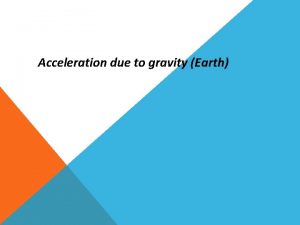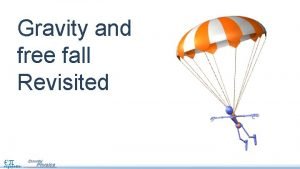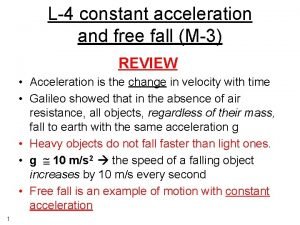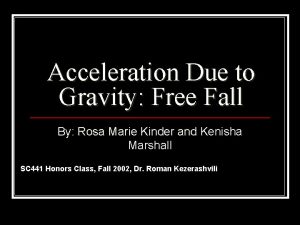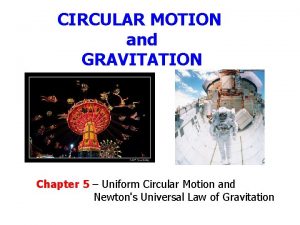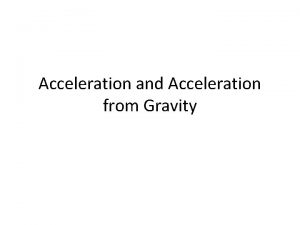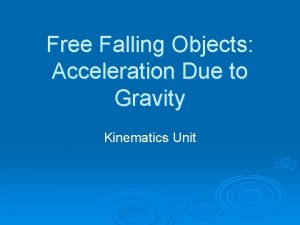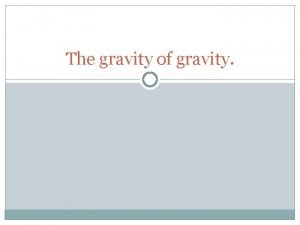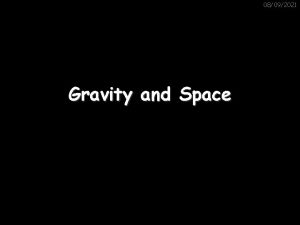Free Fall Acceleration due to gravity Free Fall












- Slides: 12

Free Fall Acceleration due to gravity

Free Fall and Galileo • All objects at same location above earth fall vertically with same acceleration • Ideal motion where air resistance is ignored= free fall • For small falls acceleration is constant • Constant acceleration means we can use the big 5 kinematics equations

Galileo • Galileo famously rocked the scientific establishment by refuting Aristotle’s claim that bigger objects fall faster • At the end of the Apollo 15 mission the astronauts tried it on the moon- without air resistance • http: //www. youtube. com/watch? v=4 m. Tsr. RZEMw A

Lab • Gravity- measuring g with a stopwatch • Each group will have a different size object • We will drop the object 10 times to average • Solve for acceleration due to gravity known as g

Acceleration due to gravity • g=9. 80 m/s 2 • We will use this value but g actually varies with: – Altitude- why? – Latitude- why?

Problem solving • Since a is constant, same kinematics equations apply • Generally we use y for displacement since it is vertical

Example: finding displacement • A stone is dropped from the top of a tall building. After 3. 00 s of free fall, what is the displacement of the stone? • We know: y a ? -9. 80 m/s 2 v v 0 t 0 m/s 3. 00 s

Example: continued • We don’t know v so we can use: y=v 0 t+1/2 at 2 y=(0 m/s)(3. 00 s) + 1/2 (-9. 80 m/s 2)(3. 00 s)2 y=-44. 1 m

Example- how high? • A football game customarily begins with a coin toss to determine who kicks off. The referee tosses the coin up with an initial speed of 5. 00 m/s. In the absence of air resistance, how high does the coin go above its point of release? • Write what you know • What’s missing? t • So which equation can we use?

Acceleration vs. Velocity • Think about flipping a coin • Where is displacement 0? • Where is instantaneous velocity 0? Draw the velocity vector at different parts of coin’s flight. • Is acceleration ever 0?

Symmetry in Free fall • Remember the saying, “what goes up must come down? ” • Objects in free fall experience symmetrical motion • At any displacement on the way up, object’s speed will be the same on the way down • Object loses 9. 80 m/s 2 on the way up and gains it on the way down • Average speed will occur halfway up/down

Hmm…some questions • If I throw a rock straight up, what will be the acceleration at the moment it reaches the top of its trajectory? • 9. 8 m/s 2 - the instantaneous velocity will be 0 as it reverses direction but acceleration is always g!
 Acceleration due to gravity
Acceleration due to gravity تسارع الجاذبية
تسارع الجاذبية Free fall formula
Free fall formula A tennis player on serve tosses a ball straight up
A tennis player on serve tosses a ball straight up Free fall explained
Free fall explained Free fall acceleration
Free fall acceleration Free fall constant acceleration
Free fall constant acceleration Conclusion of free fall
Conclusion of free fall Gravity for dummies and dummies for gravity equations
Gravity for dummies and dummies for gravity equations Acceleration of gravity
Acceleration of gravity Vertical
Vertical Tangential acceleration and centripetal acceleration
Tangential acceleration and centripetal acceleration Relation between linear and angular quantities
Relation between linear and angular quantities
